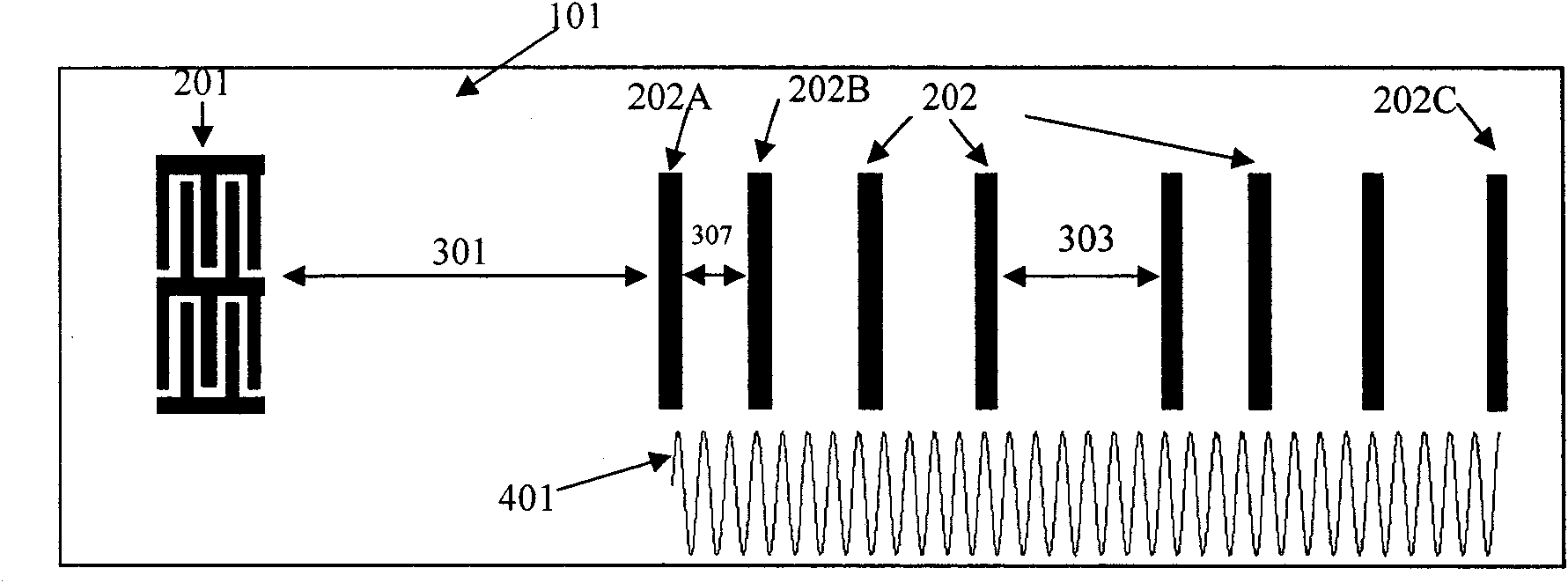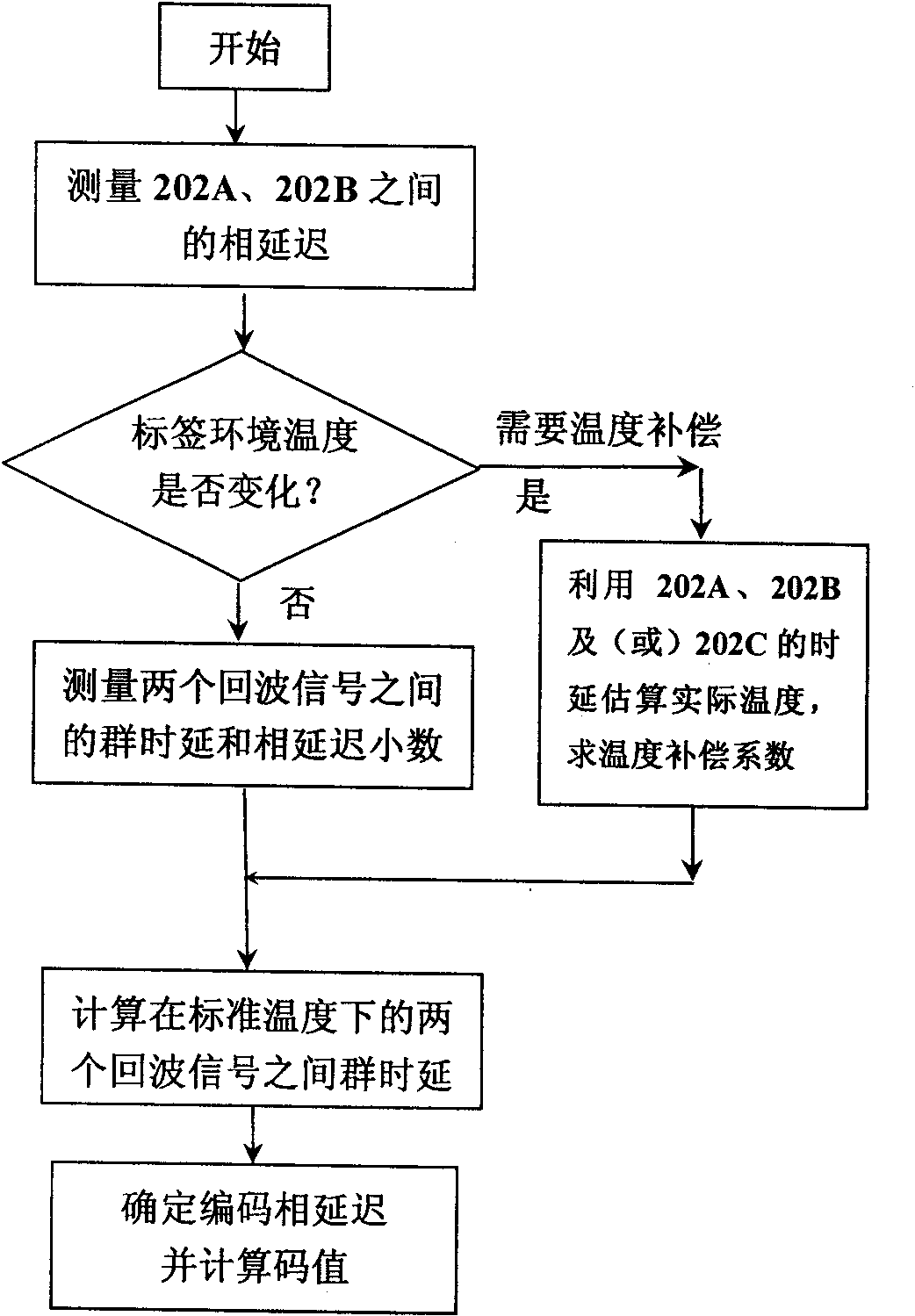Acoustic surface wave radio frequency tag with high coding capacity
A surface acoustic wave and radio frequency tag technology, applied in the field of surface acoustic wave radio frequency tags, can solve the problems of reducing coding capacity, reducing different code capacity, large measurement error, etc., and achieve the effect of large coding capacity
- Summary
- Abstract
- Description
- Claims
- Application Information
AI Technical Summary
Problems solved by technology
Method used
Image
Examples
Embodiment 1
[0036] Such as figure 1 shown, at 128°-YXLiNbO 3 The surface acoustic wave radio frequency tag 1 with the encoding method proposed by the patent of the present invention is manufactured on the piezoelectric substrate 101 . The radio frequency tag 1 includes an interdigital transducer 201 and several reflective grids 202 (there may be 2 to 40 reflective grids) arranged behind the interdigital transducer. Transducer 201 as figure 1 As shown, conventional interdigital transducers are cascaded to obtain better impedance matching. The frequency range of the wireless inquiry signal is 920-925MHz. The reflective grids 202 can be arranged in one or more rows. The position between these reflective gratings 202 is measured by the period of the surface acoustic wave 401 whose echo is at the center frequency. (Twice the phase delay at the corresponding central frequency of the reflective grating position.) The phase delay time between reflective gratings 202A, 202B, (or plus 202C) is...
Embodiment 2
[0043] The material of the piezoelectric substrate is the same as in Embodiment 1, and the length of the substrate is 11.1 mm. The positions of the three reflection grids of the temperature standard used are also the same as those in Example 1. The selected value of Δn, K min value and K max The value of is also the same as in Example 1. In this embodiment, the IDT 201 is designed as a low-loss single-phase unidirectional transducer. The encoding region 700A between the reflective grating 202B and the reflective grating 202C is still k a Δn=434Δn. The difference is that after 202C, there is a coding area 700B at the end of the substrate, where a reflective grid for code information can be placed. The transducers used and the blind zone are also the same as in the embodiment. The usable time length T can be calculated as 5087 cycles when the substrate length is 11.1 mm similarly to the embodiment. Then the size of the information space in the encoding region 700B is k T...
Embodiment 3
[0045] The piezoelectric substrate material is the same as in Example 1. In this embodiment, the center frequency of the device is 2.44GHz, and the bandwidth is 40MHz. The interdigital transducer 201 is designed as a low-loss single-phase unidirectional transducer based on high-order harmonics. The values between the positions 200 that allow the placement of reflective gratings are Δn = 6.1 periods. The minimum phase delay time interval value of adjacent pulses 302 is n min =12Δn, the maximum phase delay time interval value of adjacent pulses 303 is n max =24Δn, the size of the encoding region 700 space is k T Δn=172Δn. Can obtain code capacity by the encoding method of this patent and be 72243061840, C=log 2 72243061840 = 36.07.
PUM
 Login to View More
Login to View More Abstract
Description
Claims
Application Information
 Login to View More
Login to View More - R&D
- Intellectual Property
- Life Sciences
- Materials
- Tech Scout
- Unparalleled Data Quality
- Higher Quality Content
- 60% Fewer Hallucinations
Browse by: Latest US Patents, China's latest patents, Technical Efficacy Thesaurus, Application Domain, Technology Topic, Popular Technical Reports.
© 2025 PatSnap. All rights reserved.Legal|Privacy policy|Modern Slavery Act Transparency Statement|Sitemap|About US| Contact US: help@patsnap.com



